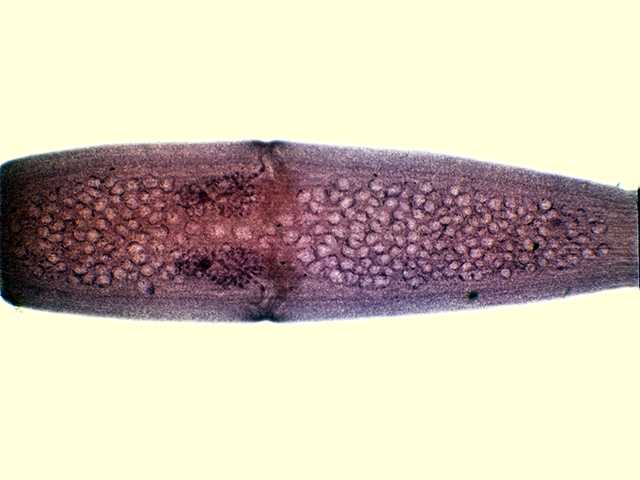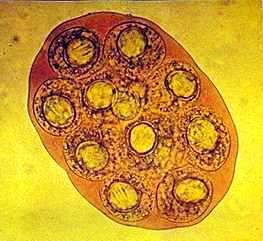Flea Tapeworm
(Dipylidium caninum)
Distribution
Worldwide.
Clinical signs
Dipylidium caninum infections are usually asymptomatic. However, the passage of gravid segments through the rectum will cause irritation and the dogs will usually ‘scoot’ and rub their perineum along the ground. In rare cases, dogs with heavy infections may develop enteritis and/or intestinal obstruction.
Diagnosis
Diagnosis can be made through history ((i.e. lack of flea control, lack of deworming with praziquantel) and by detecting proglottids in the faeces, coat, and bedding or around the anus. The proglottids of D. caninum can be differentiated from those of Taenia spp. by shape and presence of two bilaterally symmetrical genital pores located in the middle of the segment (Fig 1). Squashing a gravid proglottid will reveal egg capsules (egg packets) (Fig 2). Occasionally, egg capsules are detected by faecal flotation methods but this method is not sensitive.

Figure 1 Dipylidium caninum mature proglottid. (Image credit: The University of Melbourne parasitology image library)

Figure 2 Dipylidium caninum eggs within a capsule on faecal floatation. (Image credit: The University of Melbourne parasitology image library)
Treatment
Treatment of D. caninum infection is by praziquantel at 5 mg/kg every 2 weeks, until flea or lice control is achieved.
Control
Control can be achieved by keeping dogs and cats free of fleas (refer to flea control guidelines) and lice (refer to lice control guidelines).
Public health consideration
D.caninum infection, usually of children, occasionally occurs via ingestion of adult fleas. Children may be asymptomatic or suffer from perianal irritation and/ or light intestinal disturbances. Proglottids may be observed in the faeces or around the perianal area of the child.
